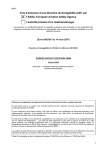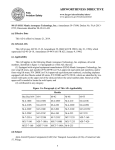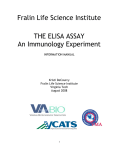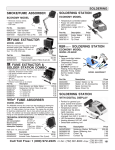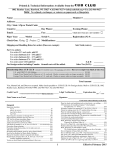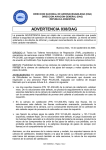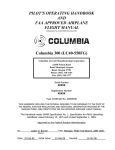Download AIRWORTHINESS DIRECTIVE
Transcript
AIRWORTHINESS DIRECTIVE FAA Aviation Safety www.faa.gov/aircraft/safety/alerts/ www.gpoaccess.gov/fr/advanced.html 2015-08-04 Various Aircraft: Amendment 39-18140; Docket No. FAA-2014-1083; Directorate Identifier 2014-CE-036-AD. (a) Effective Date This AD is effective June 3, 2015. (b) Affected ADs This AD supersedes AD 99-01-05 R1, Amendment 39-17688 (78 FR 73997, December 10, 2013; corrected 78 FR 79599, December 31, 2013) ''AD 99-01-05 R1''. AD 99-26-19 R1, Amendment 39-17681 (78 FR 76040, December 16, 2013), also relates to the subject of this AD. (c) Applicability This AD applies to the following airplanes identified in Table 1 and Table 2 to paragraph (c) of this AD, that are equipped with wing lift struts, including airplanes commonly known as a ''Clipped Wing Cub,'' which modify the airplane primarily by removing approximately 40 inches of the inboard portion of each wing; and are certificated in any category. (1) Based on optional engine installations some airplanes may have been re-identified or registered with another model that is not listed in the type certificate data sheet (TCDS). For instance, Piper Model J3C-65 airplanes are type certificated on Type Certificate Data Sheet (TCDS) A-691 but may also have been re-identified or registered as a Model J3C-115, J3F-50, J3C-75, J3C-75D, J3C75S, J3L-75, J3C-85, J3C-85S, J3C-90, J3F-90, J3F-90S, J3C-100, or J3-L4J airplane. (2) The airplane model number on the affected airplane or its registry may or may not contain the dash (-), e.g. J3 and J-3. This AD applies to both variations. Note 1 to paragraph (c) of this AD: There is a serial number overlap between the Piper PA-18 series airplanes and the Piper Model PA-19 (Army L-18C) airplanes listed in AD 99-01-05 R1. Serial numbers 18-1 through 18-7632 listed for the PA-18 series airplanes are also now listed under Model PA-19 (Army L-18C) and Model PA-19S. Table 1 to Paragraph (c) of This AD–Airplanes Previously Affected by AD 99-01-05 R1 Type certificate holder Aircraft model Serial Nos. FS 2000 Corp L-14 All. FS 2001 Corp J5A (Army L-4F), J5A-80, J5B (Army L-4G), J5C, AE-1, and HE-1 All. FS 2002 Corporation PA-14 14-1 through 14523. FS 2003 Corporation PA-12 and PA-12S 12-1 through 124036. 6 LAVIA PA-25, PA-25-235, and PA-25-260 ARGENTINA S.A. (LAVIASA) 25-1 through 258156024. Piper Aircraft, Inc TG-8 (Army TG-8, Navy XLNP-1) All. Piper Aircraft, Inc E-2 and F-2 All. Piper Aircraft, Inc J3C-40, J3C-50, J3C-50S, J3C-65 (Army L-4, L-4B, L-4H, L-4J, Navy NE-1 and NE-2), J3C-65S, J3F-50, J3F-50S, J3F-60, J3F-60S, J3F-65 (Army L-4D), J3F-65S, J3L, J3LS, J3L-65 (Army L-4C), and J3L-65S All. Piper Aircraft, Inc J4, J4A, J4A-S, and J4E (Army L-4E) 4-401 through 41649. Piper Aircraft, Inc PA-11 and PA-11S 11-1 through 111678. Piper Aircraft, Inc PA-15 15-1 through 15388. Piper Aircraft, Inc PA-16 and PA-16S 16-1 through 16736. Piper Aircraft, Inc PA-17 17-1 through 17215. Piper Aircraft, Inc PA-18, PA-18S, PA-18 “105” (Special), PA-18S “105” (Special), PA-18A, PA-18 “125” (Army L-21A), PA-18S “125”, PA-18AS “125”, PA-18 “135” (Army L-21B), PA18A “135”, PA-18S “135”, PA-18AS “135”, PA-18 “150”, PA-18A “150”, PA-18S “150”, PA-18AS “150”, PA-18A (Restricted), PA-18A “135” (Restricted), and PA-18A “150” (Restricted) 18-1 through 188309025, 18900 through 1809032, and 1809034 through 1809040. Piper Aircraft, Inc PA-19 (Army L-18C), and PA-19S 18-1 through 187632 and 19-1, 192, and 19-3. Piper Aircraft, Inc PA-20, PA-20S, PA-20 “115”, PA-20S “115”, PA-20 “135”, and PA-20S “135” 20-1 through 201121. Piper Aircraft, Inc PA-22, PA-22-108, PA-22-135, PA-22S-135, PA-22-150, PA-22S-150, PA-22-160, and PA-22S-160 22-1 through 229848. Table 2 to Paragraph (c) of This AD–Airplanes New to This AD Type certificate holder Piper Aircraft, Inc Aircraft model J-3 Serial Nos. 1100 through 1200 and 1999 and up that were manufactured before October 15, 1939. 7 Piper Aircraft, Inc J3C-65 All. (Army L-4A) Piper Aircraft, Inc J3P 2325, 2327, 2339, 2340, 2342, 2344, 2345, 2347, 2349, 2351, 2355 and up that were manufactured before January 10, 1942. Piper Aircraft, Inc J4B 4-400 and up that were manufactured before December 11, 1942. Piper Aircraft, Inc J4F 4-828 and up. (d) Subject Joint Aircraft System Component (JASC)/Air Transport Association (ATA) of America Code 57, Wings. (e) Unsafe Condition (1) The subject of this AD was originally prompted by reports of corrosion damage found on the wing lift struts. AD 99-01-05 R1 is being superseded to include certain Piper Aircraft, Inc. Models J3, J3C-65 (Army L4A), J3P, J4B, and J4F airplanes that were inadvertently omitted from the applicability, paragraph (c), of AD 99-01-05 (64 FR 72524, December 28, 1999) ''99-01-05'' and subsequently AD 99-01-05 R1. Note 2 to paragraph (e) of this AD: There is a serial number overlap between the Piper PA-18 series airplanes and the Piper Model PA-19 (Army L-18C) airplanes listed in AD 99-01-05 R1. Serial numbers 18-1 through 18-7632 listed for the PA-18 series airplanes are also now listed under Model PA-19 (Army L-18C) and Model PA-19S. (2) AD 99-01-05 R1 was issued to clarify the FAA's intention that if a sealed wing lift strut assembly is installed as a replacement part, the repetitive inspection requirement is terminated only if the seal is never improperly broken. If the seal is improperly broken, then that wing lift strut becomes subject to continued repetitive inspections. We did not intend to promote drilling holes into or otherwise unsealing a sealed strut. This AD retains all the actions required in AD 99-01-05 R1. There are no new requirements in this AD except for the addition of certain model airplanes to the applicability, paragraph (c) of this AD. (3) We are issuing this AD to detect and correct corrosion and cracking on the front and rear wing lift struts and forks, which could cause the wing lift strut to fail. This failure could result in the wing separating from the airplane. (f) Compliance Unless already done (compliance with AD 99-01-05 R1 and AD 93-10-06, Amendment 39-8586 (58 FR 29965, May 25, 1993) ''AD 93-010-06''), do the following actions within the compliance times specified in paragraphs (g) through (m) of this AD, including all subparagraphs. Properly unsealing and resealing a sealed wing lift strut is still considered a terminating action for the repetitive inspection requirements of this AD as long as all appropriate regulations and issues are considered, such as static strength, fatigue, material effects, immediate and long-term (internal and external) corrosion protection, resealing methods, etc. Current FAA regulations in 14 CFR 43.13(b) specify that maintenance performed will result in the part's condition to be at least equal to its original or properly altered condition. Any maintenance actions that unseal a sealed wing lift strut 8 should be coordinated with the Atlanta Aircraft Certification Office (ACO) through the local airworthiness authority (e.g., Flight Standards District Office). There are provisions in paragraph (n) of this AD for approving such actions as an alternative method of compliance (AMOC). (g) Remove Wing Lift Struts (1) For all airplanes previously affected by AD 99-01-05 R1: Within 1 calendar month after February 8, 1999 (the effective date retained from AD 99-01-05), or within 24 calendar months after the last inspection done in accordance with AD 93-10-06 (which was superseded by AD 99-01-05), whichever occurs later, remove the wing lift struts following Piper Aircraft Corporation Mandatory Service Bulletin (Piper MSB) No. 528D, dated October 19, 1990, or Piper MSB No. 910A, dated October 10, 1989, as applicable. Before further flight after the removal, do the actions in one of the following paragraphs (h)(1), (h)(2), (i)(1), (i)(2), or (i)(3) of this AD, including all subparagraphs. (2) For all airplanes new to this AD (not previously affected by AD 99-01-05 R1): Within 1 calendar month after the effective date of this AD or within 24 calendar months after the last inspection done in accordance with AD 93-10-06 (which was superseded by AD 99-01-05), whichever occurs later, remove the wing lift struts following Piper Aircraft Corporation Mandatory Service Bulletin (Piper MSB) No. 528D, dated October 19, 1990, or Piper MSB No. 910A, dated October 10, 1989, as applicable. Before further flight after the removal, do the actions in one of the following paragraphs (h)(1), (h)(2), (i)(1), (i)(2), or (i)(3) of this AD, including all subparagraphs. (h) Inspect Wing Lift Struts For all airplanes listed in this AD: Before further flight after the removal required in paragraph (g) of this AD, inspect each wing lift strut following paragraph (h)(1) or (h)(2) of this AD, including all subparagraphs, or do the wing lift strut replacement following one of the options in paragraph (i)(1), (i)(2), or (i)(3) of this AD. (1) Inspect each wing lift strut for corrosion and perceptible dents following Piper MSB No. 528D, dated October 19, 1990, or Piper MSB No. 910A, dated October 10, 1989, as applicable. (i) If no corrosion is visible and no perceptible dents are found on any wing lift strut during the inspection required in paragraph (h)(1) of this AD, before further flight, apply corrosion inhibitor to each wing lift strut following Piper MSB No. 528D, dated October 19, 1990, or Piper MSB No. 910A, dated October 10, 1989, as applicable. Repetitively thereafter inspect each wing lift strut at intervals not to exceed 24 calendar months following the procedures in paragraph (h)(1) or (h)(2) of this AD, including all subparagraphs. (ii) If corrosion or perceptible dents are found on any wing lift strut during the inspection required in paragraph (h)(1) of this AD or during any repetitive inspection required in paragraph (h)(1)(i) of this AD, before further flight, replace the affected wing lift strut with one of the replacement options specified in paragraph (i)(1), (i)(2), or (i)(3) of this AD. Do the replacement following the procedures specified in those paragraphs, as applicable. (2) Inspect each wing lift strut for corrosion following the procedures in the Appendix to this AD. This inspection must be done by a Level 2 or Level 3 inspector certified using the guidelines established by the American Society for Non-destructive Testing or the ''Military Standard for Nondestructive Testing Personnel Qualification and Certification'' (MIL-STD-410E). (i) If no corrosion is found on any wing lift strut during the inspection required in paragraph (h)(2) of this AD and all requirements in the Appendix to this AD are met, before further flight, apply corrosion inhibitor to each wing lift strut following Piper MSB No. 528D, dated October 19, 1990, or Piper MSB No. 910A, dated October 10, 1989, as applicable. Repetitively thereafter inspect each wing lift strut at intervals not to exceed 24 calendar months following the procedures in paragraph (h)(1) or (h)(2) of this AD, including all subparagraphs. (ii) If corrosion is found on any wing lift strut during the inspection required in paragraph (h)(2) of this AD or during any repetitive inspection required in paragraph (h)(2)(i) of this AD, or if any 9 requirement in the Appendix of this AD is not met, before further flight after any inspection in which corrosion is found or the Appendix requirements are not met, replace the affected wing lift strut with one of the replacement options specified in paragraph (i)(1), (i)(2), or (i)(3) of this AD. Do the replacement following the procedures specified in those paragraphs, as applicable. (i) Wing Lift Strut Replacement Options Before further flight after the removal required in paragraph (g) of this AD, replace the wing lift struts following one of the options in paragraph (i)(1), (i)(2), or (i)(3) of this AD, including all subparagraphs, or inspect each wing lift strut following paragraph (h)(1) or (h)(2) of this AD. (1) Install original equipment manufacturer (OEM) part number wing lift struts (or FAAapproved equivalent part numbers) that have been inspected following the procedures in either paragraph (h)(1) or (h)(2) of this AD, including all subparagraphs, and are found to be airworthy. Do the installations following Piper MSB No. 528D, dated October 19, 1990, or Piper MSB No. 910A, dated October 10, 1989, as applicable. Repetitively thereafter inspect the newly installed wing lift struts at intervals not to exceed 24 calendar months following the procedures in either paragraph (h)(1) or (h)(2) of this AD, including all subparagraphs. (2) Install new sealed wing lift strut assemblies (or FAA-approved equivalent part numbers) (these sealed wing lift strut assemblies also include the wing lift strut forks) following Piper MSB No. 528D, dated October 19, 1990, and Piper MSB No. 910A, dated October 10, 1989, as applicable. Installing one of these new sealed wing lift strut assemblies terminates the repetitive inspection requirements in paragraphs (h)(1) and (h)(2) of this AD, and the wing lift strut fork removal, inspection, and replacement requirement in paragraphs (j) and (k) of this AD, including all subparagraphs, for that wing lift strut assembly. (3) Install F. Atlee Dodge wing lift strut assemblies following F. Atlee Dodge Aircraft Services, Inc. Installation Instructions No. 3233-I for Modified Piper Wing Lift Struts Supplemental Type Certificate (STC) SA4635NM, dated February 1, 1991. Repetitively thereafter inspect the newly installed wing lift struts at intervals not to exceed 60 calendar months following the procedures in paragraph (h)(1) or (h)(2) of this AD, including all subparagraphs. (j) Remove Wing Lift Strut Forks (1) For all airplanes previously affected by AD 99-01-05 R1, except for Model PA-25, PA-25235, and PA-25-260 airplanes: Within the next 100 hours time-in-service (TIS) after February 8, 1999 (the effective date retained from AD 99-01-05) or within 500 hours TIS after the last inspection done in accordance with AD 93-10-06 (which was superseded by AD 99-01-05), whichever occurs later, remove the wing lift strut forks (unless already replaced in accordance with paragraph (i)(2) of this AD). Do the removal following Piper MSB No. 528D, dated October 19, 1990, or Piper MSB No. 910A, dated October 10, 1989, as applicable. Before further flight after the removal, do the actions in one of the following paragraphs (k) or (l) of this AD, including all subparagraphs. (2) For all airplanes new to this AD (not previously affected by AD 99-01-05 R1): Within the next 100 hours TIS after the effective date of this AD or within 500 hours TIS after the last inspection done in accordance with AD 93-10-06 (which was superseded by AD 99-01-05), whichever occurs later, remove the wing lift strut forks (unless already replaced in accordance with paragraph (i)(2) of this AD). Do the removal following Piper MSB No. 528D, dated October 19, 1990, or Piper MSB No. 910A, dated October 10, 1989, as applicable. Before further flight after the removal, do the actions in one of the following paragraphs (k) or (l) of this AD, including all subparagraphs. (k) Inspect and Replace Wing Lift Strut Forks For all airplanes affected by this AD: Before further flight after the removal required in paragraph (j) of this AD, inspect the wing lift strut forks following paragraph (k) of this AD, 10 including all subparagraphs, or do the wing lift strut fork replacement following one of the options in paragraph (l)(1), (l)(2), (l)(3), or (l)(4) of this AD, including all subparagraphs. Inspect the wing lift strut forks for cracks using magnetic particle procedures, such as those contained in FAA Advisory Circular (AC) 43.13-1B, Chapter 5, which can be found on the Internet http://rgl.faa.gov/Regulatory_and_Guidance_Library/rgAdvisoryCircular.nsf/0/99c827db9baac81b86 256b4500596c4e/$FILE/Chapter%2005.pdf. Repetitively thereafter inspect at intervals not to exceed 500 hours TIS until the replacement time requirement specified in paragraph (k)(2) or (k)(3) of this AD is reached provided no cracks are found. (1) If cracks are found during any inspection required in paragraph (k) of this AD or during any repetitive inspection required in paragraph (k)(2) or (k)(3) of this AD, before further flight, replace the affected wing lift strut fork with one of the replacement options specified in paragraph (l)(1), (l)(2), (l)(3), or (l)(4) of this AD, including all subparagraphs. Do the replacement following the procedures specified in those paragraphs, as applicable. (2) If no cracks are found during the initial inspection required in paragraph (k) of this AD and the airplane is currently equipped with floats or has been equipped with floats at any time during the previous 2,000 hours TIS since the wing lift strut forks were installed, at or before accumulating 1,000 hours TIS on the wing lift strut forks, replace the wing lift strut forks with one of the replacement options specified in paragraph (l)(1), (l)(2), (l)(3), or (l)(4) of this AD, including all subparagraphs. Do the replacement following the procedures specified in those paragraphs, as applicable. Repetitively thereafter inspect the newly installed wing lift strut forks at intervals not to exceed 500 hours TIS following the procedures specified in paragraph (k) of this AD, including all subparagraphs. (3) If no cracks are found during the initial inspection required in paragraph (k) of this AD and the airplane has never been equipped with floats during the previous 2,000 hours TIS since the wing lift strut forks were installed, at or before accumulating 2,000 hours TIS on the wing lift strut forks, replace the wing lift strut forks with one of the replacement options specified in paragraph (l)(1), (l)(2), (l)(3), or (l)(4) of this AD, including all subparagraphs. Do the replacement following the procedures specified in those paragraphs, as applicable. Repetitively thereafter inspect the newly installed wing lift strut forks at intervals not to exceed 500 hours TIS following the procedures specified in paragraph (k) of this AD, including all subparagraphs. (l) Wing Lift Strut Fork Replacement Options Before further flight after the removal required in paragraph (j) of this AD, replace the wing lift strut forks following one of the options in paragraph (l)(1), (l)(2), (l)(3), or (l)(4) of this AD, including all subparagraphs, or inspect the wing lift strut forks following paragraph (k) of this AD, including all subparagraphs. (1) Install new OEM part number wing lift strut forks of the same part numbers of the existing part (or FAA-approved equivalent part numbers) that were manufactured with rolled threads. Wing lift strut forks manufactured with machine (cut) threads are not to be used. Do the installations following Piper MSB No. 528D, dated October 19, 1990, or Piper MSB No. 910A, dated October 10, 1989, as applicable. Repetitively thereafter inspect and replace the newly installed wing lift strut forks at intervals not to exceed 500 hours TIS following the procedures specified in paragraph (k) of this AD, including all subparagraphs. (2) Install new sealed wing lift strut assemblies (or FAA-approved equivalent part numbers) (these sealed wing lift strut assemblies also include the wing lift strut forks) following Piper MSB No. 528D, dated October 19, 1990, and Piper MSB No. 910A, dated October 10, 1989, as applicable. This installation may have already been done through the option specified in paragraph (i)(2) of this AD. Installing one of these new sealed wing lift strut assemblies terminates the repetitive inspection requirements in paragraphs (h)(1) and (h)(2) of this AD, and the wing lift strut fork removal, inspection, and replacement requirements in paragraphs (j) and (k) of this AD, including all subparagraphs, for that wing lift strut assembly. 11 (3) For the airplanes specified below, install Jensen Aircraft wing lift strut fork assemblies specified below in the applicable STC following Jensen Aircraft Installation Instructions for Modified Lift Strut Fitting. Installing one of these wing lift strut fork assemblies terminates the repetitive inspection requirement of this AD only for that wing lift strut fork. Repetitively inspect each wing lift strut as specified in paragraph (h)(1) or (h)(2) of this AD, including all subparagraphs. (i) For Models PA-12 and PA-12S airplanes: STC SA1583NM, which can be found on the Internet at http://rgl.faa.gov/Regulatory_and_Guidance_Library/rgstc.nsf/0/2E708575849845B285256CC10082 13CA?OpenDocument&Highlight=sa1583nm; (ii) For Model PA-14 airplanes: STC SA1584NM, which can be found on the Internet at http://rgl.faa.gov/Regulatory_and_Guidance_Library/rgstc.nsf/0/39872B814471737685256CC10082 13D0?OpenDocument&Highlight=sa1584nm; (iii) For Models PA-16 and PA-16S airplanes: STC SA1590NM, which can be found on the Internet at http://rgl.faa.gov/Regulatory_and_Guidance_Library/rgstc.nsf/0/B28C4162E30D941F85256CC1008 213F6?OpenDocument&Highlight=sa1590nm; (iv) For Models PA-18, PA-18S, PA-18 ''105'' (Special), PA-18S ''105'' (Special), PA-18A, PA18 ''125'' (Army L-21A), PA-18S ''125'', PA-18AS ''125'', PA-18 ''135'' (Army L-21B), PA-18A ''135'', PA-18S ''135'', PA-18AS ''135'', PA-18 ''150'', PA-18A ''150'', PA-18S ''150'', PA-18AS ''150'', PA-18A (Restricted), PA-18A ''135'' (Restricted), and PA-18A ''150'' (Restricted) airplanes: STC SA1585NM, which can be found on the Internet at http://rgl.faa.gov/Regulatory_and_Guidance_Library/rgstc.nsf/0/A2BE010FB1CA61A285256CC100 8213D6?OpenDocument&Highlight=sa1585nm; (v) For Models PA-20, PA-20S, PA-20 ''115'', PA-20S ''115'', PA-20 ''135'', and PA-20S ''135'' airplanes: STC SA1586NM, which can be found on the Internet at http://rgl.faa.gov/Regulatory_and_Guidance_Library/rgstc.nsf/0/873CC69D42C87CF585256CC1008 213DC?OpenDocument&Highlight=sa1586nm; and (vi) For Model PA-22 airplanes: STC SA1587NM, which can be found on the Internet at http://rgl.faa.gov/Regulatory_and_Guidance_Library/rgstc.nsf/0/B051D04CCC0BED7E85256CC10 08213E0?OpenDocument&Highlight=sa1587nm. (4) Install F. Atlee Dodge wing lift strut assemblies following F. Atlee Dodge Installation Instructions No. 3233-I for Modified Piper Wing Lift Struts (STC SA4635NM), dated February 1, 1991. This installation may have already been done in accordance paragraph (i)(3) of this AD. Installing these wing lift strut assemblies terminates the repetitive inspection requirements of this AD for the wing lift strut fork only. Repetitively inspect the wing lift struts as specified in paragraph (h)(1) or (h)(2) of this AD, including all subparagraphs. (m) Install Placard (1) For all airplanes previously affected by AD 99-01-05 R1, except for Models PA-25, PA-25235, and PA-25-260 airplanes: Within 1 calendar month after February 8, 1999 (the effective date retained from AD 99-01-05), or within 24 calendar months after the last inspection required by AD 93-10-06 (which was superseded by AD 99-01-05), whichever occurs later, and before further flight after any replacement of a wing lift strut assembly required by this AD, do one of the following actions in paragraph (m)(1)(i) or (m)(1)(ii) of this AD. The ''NO STEP'' markings required by paragraph (m)(1)(i) or (m)(1)(ii) of this AD must remain in place for the life of the airplane. (i) Install ''NO STEP'' decal, Piper (P/N) 80944-02, on each wing lift strut approximately 6 inches from the bottom of the wing lift strut in a way that the letters can be read when entering and exiting the airplane; or (ii) Paint the words ''NO STEP'' approximately 6 inches from the bottom of the wing lift strut in a way that the letters can be read when entering and exiting the airplane. Use a minimum of 1-inch letters using a color that contrasts with the color of the airplane. 12 (2) For all airplanes new to this AD (not previously affected by AD 99-01-05 R1): Within 1 calendar month after the effective date of this AD or within 24 calendar months after the last inspection required by AD 93-10-06 (which was superseded by AD 99-01-05), whichever occurs later, and before further flight after any replacement of a wing lift strut assembly required by this AD, do one of the following actions in paragraph (m)(2)(i) or (m)(2)(ii) of this AD. The ''NO STEP'' markings required by paragraph (m)(2)(i) or (m)(2)(ii) of this AD must remain in place for the life of the airplane. (i) Install ''NO STEP'' decal, Piper (P/N) 80944-02, on each wing lift strut approximately 6 inches from the bottom of the wing lift strut in a way that the letters can be read when entering and exiting the airplane; or (ii) Paint the words ''NO STEP'' approximately 6 inches from the bottom of the wing lift strut in a way that the letters can be read when entering and exiting the airplane. Use a minimum of 1-inch letters using a color that contrasts with the color of the airplane. (n) Alternative Methods of Compliance (AMOCs) (1) The Manager, Atlanta ACO, FAA, has the authority to approve AMOCs for this AD related to Piper Aircraft, Inc. airplanes; the Manager, Seattle ACO, FAA has the authority to approve AMOCs for this AD related to FS 2000 Corp, FS 2001 Corp, FS 2002 Corporation, and FS 2003 Corporation airplanes; and the Manager, Standards Office, FAA, has the authority to approve AMOCs for this AD related to LAVIA ARGENTINA S.A. (LAVIASA) airplanes, if requested using the procedures found in 14 CFR 39.19. In accordance with 14 CFR 39.19, send your request to your principal inspector or local Flight Standards District Office, as appropriate. If sending information directly to the manager of the ACO, send it to the attention of the appropriate person identified in paragraph (o) of this AD. (2) Before using any approved AMOC, notify your appropriate principal inspector, or lacking a principal inspector, the manager of the local flight standards district office/certificate holding district office. (3) AMOCs approved for AD 93-10-06, AD 99-01-05, and AD 99-01-05 R1, are approved as AMOCs for this AD. (o) Related Information (1) For more information about this AD related to Piper Aircraft, Inc. airplanes, contact: Gregory ''Keith'' Noles, Aerospace Engineer, FAA, Atlanta ACO, 1701 Columbia Avenue, College Park, Georgia 30337; phone: (404) 474-5551; fax: (404) 474-5606; email: [email protected]. (2) For more information about this AD related to FS 2000 Corp, FS 2001 Corp, FS 2002 Corporation, and FS 2003 Corporation airplanes, contact: Jeff Morfitt, Aerospace Engineer, FAA, Seattle ACO, 1601 Lind Avenue SW., Renton, Washington 98057; phone: (425) 917-6405; fax: (245) 917-6590; email: [email protected]. (3) For more information about this AD related to LAVIA ARGENTINA S.A. (LAVIASA) airplanes, contact: S.M. Nagarajan, Aerospace Engineer, FAA, Small Airplane Directorate, 901 Locust, Room 301, Kansas City, Missouri 64106; telephone: (816) 329-4145; fax: (816) 329-4090; email: [email protected]. (p) Material Incorporated by Reference (1) The Director of the Federal Register approved the incorporation by reference (IBR) of the service information listed in this paragraph under 5 U.S.C. 552(a) and 1 CFR part 51. (2) You must use this service information as applicable to do the actions required by this AD, unless the AD specifies otherwise. 13 (3) The following service information was approved for IBR on February 8, 1999 (63 FR 72132, December 31, 1998). (i) Piper Aircraft Corporation Mandatory Service Bulletin No. 528D, dated October 19, 1990. (ii) Piper Aircraft Corporation Mandatory Service Bulletin No. 910A, dated October 10, 1989. (iii) F. Atlee Dodge Aircraft Services, Inc. Installation Instructions No. 3233-I for Modified Piper Wing Lift Struts Supplemental Type Certificate (STC) SA4635NM, dated February 1, 1991. (iv) Jensen Aircraft Installation Instructions for Modified Lift Strut Fittings, which incorporates pages 1 and 5, Original Issue, dated July 15, 1983; pages 2, 4, and 6, Revision No. 1, dated March 30, 1984; and pages a and 3, Revision No. 2, dated April 20, 1984. (4) For Piper Aircraft, Inc. service information identified in this AD, contact Piper Aircraft, Inc., Customer Services, 2926 Piper Drive, Vero Beach, Florida 32960; telephone: (772) 567-4361; Internet: www.piper.com. Copies of the instructions to the F. Atlee Dodge STC and information about the Jensen Aircraft STCs may be obtained from F. Atlee Dodge, Aircraft Services, LLC., 6672 Wes Way, Anchorage, Alaska 99518-0409, Internet: www.fadodge.com. (5) You may review copies of the referenced service information at the FAA, Small Airplane Directorate, 901 Locust, Kansas City, Missouri 64106. For information on the availability of this material at the FAA, call (816) 329-4148. It is also available on the Internet at http://www.regulations.gov by searching for and locating Docket No. FAA-2014-1083. (6) You may view this service information that is incorporated by reference at the National Archives and Records Administration (NARA). For information on the availability of this material at NARA, call 202-741-6030, or go to: http://www.archives.gov/federal-register/cfr/ibr-locations.html. Appendix to AD 2015-08-04 Procedures and Requirements for Ultrasonic Inspection of Piper Wing Lift Struts Equipment Requirements 1. A portable ultrasonic thickness gauge or flaw detector with echo-to-echo digital thickness readout capable of reading to 0.001-inch and an A-trace waveform display will be needed to do this inspection. 2. An ultrasonic probe with the following specifications will be needed to accomplish this inspection: 10 MHz (or higher), 0.283-inch (or smaller) diameter dual element or delay line transducer designed for thickness gauging. The transducer and ultrasonic system shall be capable of accurately measuring the thickness of AISI 4340 steel down to 0.020-inch. An accuracy of 0.002inch throughout a 0.020-inch to 0.050-inch thickness range while calibrating shall be the criteria for acceptance. 3. Either a precision machined step wedge made of 4340 steel (or similar steel with equivalent sound velocity) or at least three shim samples of same material will be needed to accomplish this inspection. One thickness of the step wedge or shim shall be less than or equal to 0.020-inch, one shall be greater than or equal to 0.050-inch, and at least one other step or shim shall be between these two values. 4. Glycerin, light oil, or similar non-water based ultrasonic couplants are recommended in the setup and inspection procedures. Water-based couplants, containing appropriate corrosion inhibitors, may be utilized, provided they are removed from both the reference standards and the test item after the inspection procedure is completed and adequate corrosion prevention steps are then taken to protect these items. • NOTE: Couplant is defined as ''a substance used between the face of the transducer and test surface to improve transmission of ultrasonic energy across the transducer/strut interface.'' • NOTE: If surface roughness due to paint loss or corrosion is present, the surface should be sanded or polished smooth before testing to assure a consistent and smooth surface for making contact with the transducer. Care shall be taken to remove a minimal amount of 14 structural material. Paint repairs may be necessary after the inspection to prevent further corrosion damage from occurring. Removal of surface irregularities will enhance the accuracy of the inspection technique. 1. Set up the ultrasonic equipment for thickness measurements as specified in the instrument's user's manual. Because of the variety of equipment available to perform ultrasonic thickness measurements, some modification to this general setup procedure may be necessary. However, the tolerance requirement of step 13 and the record keeping requirement of step 14, must be satisfied. 2. If battery power will be employed, check to see that the battery has been properly charged. The testing will take approximately two hours. Screen brightness and contrast should be set to match environmental conditions. 3. Verify that the instrument is set for the type of transducer being used, i.e. single or dual element, and that the frequency setting is compatible with the transducer. 4. If a removable delay line is used, remove it and place a drop of couplant between the transducer face and the delay line to assure good transmission of ultrasonic energy. Reassemble the delay line transducer and continue. 5. Program a velocity of 0.231-inch/microsecond into the ultrasonic unit unless an alternative instrument calibration procedure is used to set the sound velocity. 6. Obtain a step wedge or steel shims per item 3 of the EQUIPMENT REQUIREMENTS. Place the probe on the thickest sample using couplant. Rotate the transducer slightly back and forth to ''ring'' the transducer to the sample. Adjust the delay and range settings to arrive at an A-trace signal display with the first backwall echo from the steel near the left side of the screen and the second backwall echo near the right of the screen. Note that when a single element transducer is used, the initial pulse and the delay line/steel interface will be off of the screen to the left. Adjust the gain to place the amplitude of the first backwall signal at approximately 80% screen height on the A-trace. 7. ''Ring'' the transducer on the thinnest step or shim using couplant. Select positive half-wave rectified, negative half-wave rectified, or filtered signal display to obtain the cleanest signal. Adjust the pulse voltage, pulse width, and damping to obtain the best signal resolution. These settings can vary from one transducer to another and are also user dependent. 8. Enable the thickness gate, and adjust the gate so that it starts at the first backwall echo and ends at the second backwall echo. (Measuring between the first and second backwall echoes will produce a measurement of the steel thickness that is not affected by the paint layer on the strut). If instability of the gate trigger occurs, adjust the gain, gate level, and/or damping to stabilize the thickness reading. 9. Check the digital display reading and if it does not agree with the known thickness of the thinnest thickness, follow your instrument's calibration recommendations to produce the correct thickness reading. When a single element transducer is used this will usually involve adjusting the fine delay setting. 10. Place the transducer on the thickest step of shim using couplant. Adjust the thickness gate width so that the gate is triggered by the second backwall reflection of the thick section. If the digital display does not agree with the thickest thickness, follow your instruments calibration recommendations to produce the correct thickness reading. A slight adjustment in the velocity may be necessary to get both the thinnest and the thickest reading correct. Document the changed velocity value. 11. Place couplant on an area of the lift strut which is thought to be free of corrosion and ''ring'' the transducer to surface. Minor adjustments to the signal and gate settings may be required to account for coupling improvements resulting from the paint layer. The thickness gate level should be set just high enough so as not to be triggered by irrelevant signal noise. An area on the upper surface of the lift strut above the inspection area would be a good location to complete this step and should produce a thickness reading between 0.034-inch and 0.041-inch. 12. Repeat steps 8, 9, 10, and 11 until both thick and thin shim measurements are within tolerance and the lift strut measurement is reasonable and steady. 15 13. Verify that the thickness value shown in the digital display is within 0.002-inch of the correct value for each of the three or more steps of the setup wedge or shims. Make no further adjustments to the instrument settings. 14. Record the ultrasonic versus actual thickness of all wedge steps or steel shims available as a record of setup. 1. Clean the lower 18 inches of the wing lift struts using a cleaner that will remove all dirt and grease. Dirt and grease will adversely affect the accuracy of the inspection technique. Light sanding or polishing may also be required to reduce surface roughness as noted in the EQUIPMENT REQUIREMENTS section. 2. Using a flexible ruler, draw a 1/4-inch grid on the surface of the first 11 inches from the lower end of the strut as shown in Piper MSB No. 528D, dated October 19, 1990, or Piper MSB No. 910A, dated October 10, 1989, as applicable. This can be done using a soft (#2) pencil and should be done on both faces of the strut. As an alternative to drawing a complete grid, make two rows of marks spaced every 1/4-inch across the width of the strut. One row of marks should be about 11 inches from the lower end of the strut, and the second row should be several inches away where the strut starts to narrow. Lay the flexible ruler between respective tick marks of the two rows and use tape or a rubber band to keep the ruler in place. See Figure 1. 3. Apply a generous amount of couplant inside each of the square areas or along the edge of the ruler. Re-application of couplant may be necessary. 4. Place the transducer inside the first square area of the drawn grid or at the first 1/4-inch mark on the ruler and ''ring'' the transducer to the strut. When using a dual element transducer, be very careful to record the thickness value with the axis of the transducer elements perpendicular to any curvature in the strut. If this is not done, loss of signal or inaccurate readings can result. 5. Take readings inside each square on the grid or at 1/4-inch increments along the ruler and record the results. When taking a thickness reading, rotate the transducer slightly back and forth and experiment with the angle of contact to produce the lowest thickness reading possible. Pay close attention to the A-scan display to assure that the thickness gate is triggering off of maximized backwall echoes. NOTE: A reading shall not exceed .041 inch. If a reading exceeds .041-inch, repeat steps 13 and 14 of the INSTRUMENT SETUP section before proceeding further. 6. If the A-trace is unsteady or the thickness reading is clearly wrong, adjust the signal gain and/or gate setting to obtain reasonable and steady readings. If any instrument setting is adjusted, repeat steps 13 and 14 of the INSTRUMENT SETUP section before proceeding further. 7. In areas where obstructions are present, take a data point as close to the correct area as possible. NOTE: The strut wall contains a fabrication bead at approximately 40% of the strut chord. The bead may interfere with accurate measurements in that specific location. 8. A measurement of 0.024-inch or less shall require replacement of the strut prior to further flight. 9. If at any time during testing an area is encountered where a valid thickness measurement cannot be obtained due to a loss of signal strength or quality, the area shall be considered suspect. These areas may have a remaining wall thickness of less than 0.020-inch, which is below the range of this setup, or they may have small areas of localized corrosion or pitting present. The latter case will result in a reduction in signal strength due to the sound being scattered from the rough surface and may result in a signal that includes echoes from the pits as well as the backwall. The suspect area(s) shall be tested with a Maule ''Fabric Tester'' as specified in Piper MSB No. 528D, dated October 19, 1990, or Piper MSB No. 910A, dated October 10, 1989. 10. Record the lift strut inspection in the aircraft log book. 16 Issued in Kansas City, Missouri, on April 8, 2015. Earl Lawrence, Manager, Small Airplane Directorate, Aircraft Certification Service. 17












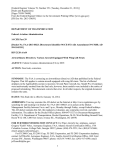
![[4910-13-U] DEPARTMENT OF TRANSPORTATION Federal](http://vs1.manualzilla.com/store/data/005730800_1-83b69f38eee92750e4a30066087ffbc6-150x150.png)
